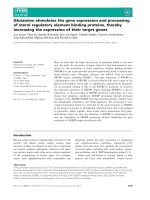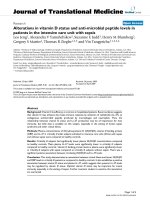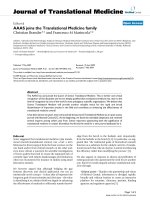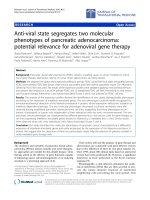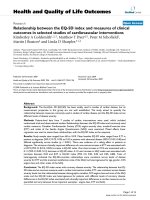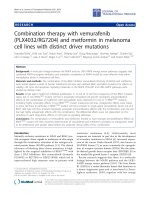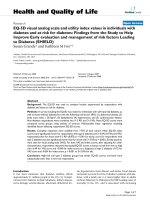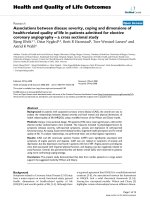báo cáo hóa học:" Combination therapy: the next opportunity and challenge of medicine" potx
Bạn đang xem bản rút gọn của tài liệu. Xem và tải ngay bản đầy đủ của tài liệu tại đây (199.24 KB, 3 trang )
EDI T O R I A L Open Access
Combination therapy: the next opportunity and
challenge of medicine
Paolo A Ascierto
1*
and Francesco M Marincola
2
Abstract
From an historical point of view, combination therapy was the basis for the care of important diseases like
infection diseases or cancer. Today the “cocktail drug” of the Highly Active Anti Retroviral Therapy (HAART) has
reduced the death for HIV infection changing the outcome of such disease. Moreover, the combination of different
strategies changed the course of transplants (both in haematology and surgical transplant). Different diseases with
high social impact including cardiovascular, metabolic (obesity, hypercholesterolaemia and diabetes) and
autoimmune diseases, have better results with combinations of different drug classes of drugs. After recent
successes in the immunotherapy field (Sepuleucel-T, ipilimumab) and the new promising small molecule therapies,
cancer should be the next challenge for combination strategies.
In order to accomplish these objectives open discussion
and cooperation among companies, academic, and other
institutions will be increasingly important. For all of
these reasons, we have created a new subsection of the
Journal of Translational Medicine.
Why should a Subsection of the Journal of Translational
Medicine be dedicated to combination strategies? Because
we want to stimulate discussion over this hot topic. In
recent years, several compounds have been developed to
treat a b road number of diseases targeting a specific
mechanism. However, vast majority of common diseases
are multi-factorial and cannot realistically be controlled by
targeting a single or few pathways.
Tuberculosis treatment is a classic example of combina-
tion therapy [1]. After the discovery of Streptomycin in
1944, improveme nt in the effectivene ss of therapy was
observed with the addition of Isoniazid, the first oral myco-
bactericidal drug in 1952 and Rifamycins in 1957. Th e
introduction of Rifampicin in 1970 further improved the
effectiveness of the treatment of tuberculosis. As for this
example, the main reason for the improved effectiveness of
combination therapy is prevention of the emergence of
resistance to individual drugs. Moreover, different drugs
displaying different pharmacodynamics and/or pharmaco-
kinetics could target subpopulations of mycobacteria
independently on metabolic stage or location within the
organism.
With the advent of novel immunosuppressive agents
allograft rejection is prevented in an increasingly more
effective manner with reduced toxicity [2]. Drugs like
Cyclosporin A, Tacrolimus (FK506), Voclosporin (ISA247),
Sotrastaurin (AEB071), Sirolimus, Everolimus, Mycopheno-
lic acid, Azathioprine, CP-690550, Belatacept (LEA29Y),
Alefacept Humanized LFA3-Ig, Basiliximab, Alemtuzumab,
Muromonab-CD3, Rituximab, Bortezomib Tripeptide,
Eculizumab incrementally reduced the risk of transplant
rejection when used in combination. Other important
examples of effective combinatorial approaches are repre-
sented by Human Immunodeficiency Virus (HIV) and
Hepatitis C Virus (HCV) infections. The discovery of sev-
eral classes of drugs that exert different anti-viral mechan-
isms dramatically changed the prognosis in these patients.
TheHighlyActiveAntiRetroviralTherapy(HAART)
changed HIV infection from an incurable disease to a
chronic illness. According to Julio Montaner, director of
the British Columbia Centre for Excellence in HIV/AIDS,
“results show a strong and significant association between
increased HAART coverage, reduced community viral
load, an d decr eased number of ne w HIV diagnoses p er
year in the population of a Canadian province” [3]. “While
waiting for an effective vaccine, experiences such as those
reported today should be strongly considered by clinicians,
national and international agencies, policy makers, and all
parties involved in the development of treatment
* Correspondence:
1
Medical Oncology and Innovative Therapies Unit, Istituto Nazionale per lo
Studio e la Cura dei Tumori, Fondazione “G. Pascale”, Napoli, Italy
Full list of author information is available at the end of the article
Ascierto and Marincola Journal of Translational Medicine 2011, 9:115
/>© 2011 Ascierto and Mari ncola; licensee BioMed Central Ltd. This is an Open Access article distributed under the terms of the Creative
Commons Attribution License (http://creativecom mons.org/licenses/by/2.0), which permits unrest ricted use, distri bution, and
reproduction in any medium, provided the original work is properly cited.
guidelines, because the population-based dimension of
HAART might play an important part in the future control
of the HIV epidemic” wrote Franco Maggiolo and Sebas -
tiano Leone [4].
Combination therapy with several drugs is the approach
used in several cardiovascular diseases. Acute Coronary
Syndrome [5] and Pulmonary Arterial Hypertension [6]
are classical examples. Moreover, an abundance of studies
demonstrate additive antihypertensive benefit by combin-
ing 2 agents of different classes in Essential Hypertension.
The extra blood pressure reduction from combining drugs
from 2 different classes is approximately 5 times greater
than doubling the dose of 1 drug [7]. This is particularly
true for thiazide diuretics, which significantly improve
blood pressure control w hen used in combination with
most if not all other classes of agents [8]. Often Cardiac
Disease are associated with other metabolic dis eases like
hypercholesterolaemia and diabetes; each of them is
further and effectively treated with the association of
different compounds [9,10].
Even autoimmune dise ases can benefit from combina-
tion therapy. Crohn’s disease [11] and rheumatoid arthri-
tis (RA) are good examples of such an approach. In fact,
rec ently antitumour necrosis factor (anti-TNF) the rapies
are now routinely used in the management of rheuma-
toid arthritis in patients for whom traditional disease-
modifying antirheumatic drugs (DMARDs) have failed. A
better response has been demonstrated wi th any of three
anti-TNF therapies [etanercept (ETN), infliximab (INF)
and adalimumab (ADA)] when used in combination with
methotrexate (MTX) than when used as mono therapies
(Nixon). Moreover, combining anti-TNF with MTX in
combination with one or more other DMARDs [sulfasa-
lazine (SSZ), hydroxychloroquine (HCQ) or both]
resulted in better long-term treatment persistence [12].
But this is only the beginning! Treatment of cancer may
indeed represent the field where combination strategies
surely play a crucial role. In fact, a combination of surgery,
radiotherapy, and chemotherapy has been the standard
care for the treatment of breast, ovarian, and head and
neck cancer. However, in the last decade, the approaches
to cancer therapy have change d. In 1998, the approval of
trastuzumab for the treatment of breast cancer was a mile-
stone which established a new class of cancer treatment
that utilizes immune based mechanisms rather than cyto-
toxic drugs. In 2001, imatinib was approved for the treat-
ment of chronic myeloid leukemia and its utilization had a
dramatic impact on long term survival. Since then,
new drugs targeting specific mechanisms have been
employed for the treatment of several types of cancer . In
some cases promising results had an impact on subse-
quent approaches (bevacizu mab, cetuximab, sorafenib,
sutent) whereas other d rugs failed to reach the expected
results (gefitinib, CpG). Ipilimumab, a further example: a
target agent that, through an indirect action on the
immune system, induces anti-neoplastic activity against
cancers such as melanoma, prostate cancer and NSCLC,
has recently obtained Food and Drug Administration
(FDA) approval for advanced melanoma treatment [13].
Together with other recent successes in immu notherap y,
2010 became a milestone year for the biological therapy of
cancer. In 2010, the first anti-cancer vaccine received FDA
approval (Sepuleucel-T for the treatment of prostate can-
cer) [14] as well as Vemurafinib (PLX4032) or the specific
inhibitor of mutated BRAF (V600E) has demonstrated dra-
matic effectiveness in melano ma patients [15]. Neverth e-
less, we have new interesting targeted agents (ALK
inhibitor, MEK, PI3K and AKT inhibitor s, anti-PD1,
demethylating agents, oncolytic viral vaccine, etc.) that are
ready to be used in clinical trial. Thus, we have been treat-
ing cancer attacking one pathways/mechanism at a time
disregarding the complexity, redundancy, and compensa-
tory mechanisms typical of this rapidly evolving disease.
Thus far, not many examples of combinatorial approaches
have been tested; it would be highly desirable to follow the
successful example of the treatment of HIV with HAART.
A multi-target therapy could combine novel agents with
standard c hemotherapy or novel agents with different
mechanisms or action. Sequential administration of differ-
ent agents may inhibit cancer cell growth at different
check points, while other agents may inhibit neo-angio-
genesis, survival of malignant cells or metastases, poten-
tially converting cancer into a chronic disease [16].
Toxicity will surely represent one limitation In fact, i f
we look at HAART, toxicity from the combination of
several drugs should not be overlooked [17]. On the
other hand, it is known that the combination o f differ-
ent strategies may amplify the various side effects of
everysingledrugs.However,wemustbereadytoface
such issues if the goal is to turn an incurable lethal dis-
ease into a manageable disease.
The challenge will be to test novel combinations particu-
larly for drugs that have not been as yet licensed. Clinical
trials are often influenced by the financial pressure aimed
at demonstrating product effectiveness for licensing rather
than systematically designing trials to evaluate the
mechanisms of action of the therapy as well as whether
biological end-point are achieved or why treatment might
have failed. Such information could provide clues for the
design of more sophisticated follow up studies using novel
agents. Thus, several drugs tested as single agents risk
being withdrawn and becoming unavailable for continue
research by early negative clinical results from studies that
had not been planned carefully to understand the potential
activity of the drug when administered to human beings. It
may be important to rescue drugs that “failed” when used
as single agents to study their effectiveness in combination
with others that have different but potentially synergistic
Ascierto and Marincola Journal of Translational Medicine 2011, 9:115
/>Page 2 of 3
mechanisms of action. Going back to infectious diseases, a
good example is the association of the combination
between pegylated interferon-alpha and Ribavarin, two
drugs that alone demonstrated very minimal benefit, for
the treatment of chronic HCV [18].
Testing drugs in combination may be hampered not
only by scientific or regulatory hurdles, but also by the
difficulty of obtaining the interest and participatin of
individual companies. Segregation of products according
to market niches and proprietary arguments is limiting
the utilization of promising products in combination
and their potential application to broad patient popula-
tions as licensable combination therapy.
For all the above reasons, we are creating a subsection of
the Journal of Translational Medicine dedicated to combi-
nation strategies as a forum to stimulate discussion
between academia, industry and other institutions in order
to emphasis the identification of clinical trial strategies uti-
lizing combinations of treatment. Although cancer and
infectious diseases ha ve been recently in the front line of
the interest for combin atorial appro aches, we re cognize
that other disciplines such as cardiovascular, autoimmune,
metabolic and other chronic disorders characterized by
complex biology will benefit of drug combination
approaches in next future. Therefore, this subsection is
now open to submissio ns relevant to this topic, indepen-
dently on the target disease.
Author details
1
Medical Oncology and Innovative Therapies Unit, Istituto Nazionale per lo
Studio e la Cura dei Tumori, Fondazione “G. Pascale”, Napoli, Italy.
2
Infectious
Disease and Immunogenetics Section (IDIS), Department of Transfusion
Medicine, Clinical Center and trans-NIH Center for Human Immunology (CHI)
National Institutes of Health, Bethesda, Maryland, 20892, USA.
Received: 11 July 2011 Accepted: 21 July 2011 Published: 21 July 2011
References
1. Daniel TM: The history of tuberculosis. Resp Med 2006, 100:1862-70.
2. Sánchez-Fueyo A, Strom TB: Immunologic basis of graft rejection and
tolerance following transplantation of liver or other solid organs.
Gastroenterology 2011, 140:51-64.
3. Montaner JSG, Lima VD, Barrios R, Yip B, Wood E, Kerr T, Shannon K,
Harrigan PR, Hogg RS, Daly P, Kendall P: Association of highly active
antiretroviral therapy coverage, population viral load, and yearly new
HIV diagnoses in British Columbia, Canada: a population-based study.
Lancet 2010, 376:532-39.
4. Maggiolo F, Leone S: Is HAART modifying the HIV epidemic? Lancet 2010,
376:492-3.
5. Al-Zakwani I, Zubaid M, Panduranga P, Rashed W, Sulaiman K,
Almahmeed W, Al-Motarreb A, Al Suwaidi J, Amin H: Medication Use
Pattern and Predictors of Optimal Therapy at Discharge in 8176 Patients
With Acute Coronary Syndrome From 6 Middle Eastern Countries: Data
From the Gulf Registry of Acute Coronary Events. Angiology 2011.
6. Mukherjee B, Howard L: Combination therapy in pulmonary arterial
hypertension: do we have the right strategy? Expert Rev Respir Med 2011,
5:191-205.
7. Wald DS, Law M, Morris JK, Bestwick JP, Wald NJ: Combination therapy
versus monotherapy in reducing blood pressure: meta-analysis on
11,000 participants from 42 trials. Am J Med 2009, 122:290-300.
8. Calhoun DA, Jones D, Textor S, Goff DC, Murphy TP, Toto RD, White A,
Cushman WC, White W, Sica D, Ferdinand K, Giles TD, Falkner B, Carey RM:
Resistant hypertension: diagnosis, evaluation, and treatment. A scientific
statement from the American Heart Association Professional Education
Committee of the Council for High Blood Pressure Research. Hypertension
2008, 51:1403-19.
9. Friedman HS, Rajagopalan S, Barnes JP, Roseman H: Combination therapy
with ezetimibe/simvastatin versus statin monotherapy for low-density
lipoprotein cholesterol reduction and goal attainment in a real-world
clinical setting. Clin Ther 2011, 33:212-24.
10. Sawakhanda RB, Dharmalingam M, Kumar S, Bell D: Triple oral fixed dose
diabetes polypill vs. Insulin plus Metformin efficacy demonstration study
in the treatment of advanced type 2 diabetes (TrIED study-II). Diabetes
Obes Metab 2011.
11. Colombel JF, Sandborn WJ, Reinisch W, Mantzaris GJ, Kornbluth A,
Rachmilewitz D, Lichtiger S, D’Haens G, Diamond RH, Broussard DL,
Tang KL, van der Woude CJ, Rutgeerts P, SONIC Study Group: Infliximab,
azathioprine, or combination therapy for Crohn’s disease. N Engl J Med
2010, 362:1383-95.
12. Soliman MM, Ashcroft DM, Watson KD, Lunt M, Symmons DP, Hyrich KL,
British Society for Rheumatology Biologics Register: Impact of concomitant
use of DMARDs on the persistence with anti-TNF therapies in patients
with rheumatoid arthritis: results from the British Society for
Rheumatology Biologics Register. Ann Rheum Dis 2011, 70(4):583-9, Epub
2011 Feb 17.
13. Hodi FS, O’Day SJ, McDermott DF, Weber RW, Sosman JA, Haanen JB,
Gonzalez R, Robert C, Schadendorf D, Hassel JC, Akerley W, van den
Eertwegh AJ, Lutzky J, Lorigan P, Vaubel JM, Linette GP, Hogg D,
Ottensmeier CH, Lebbé C, Peschel C, Quirt I, Clark JI, Wolchok JD, Weber JS,
Tian J, Yellin MJ, Nichol GM, Hoos A, Urba WJ: Improved survival with
ipilimumab in patients with metastatic melanoma. N Engl J Med 2010,
363
:711-23.
14. Kantoff PW, Higano CS, Shore ND, Berger ER, Small EJ, Penson DF,
Redfern CH, Ferrari AC, Dreicer R, Sims RB, Xu Y, Frohlich MW,
Schellhammer PF, IMPACT Study Investigators: Sipuleucel-T
immunotherapy for castration-resistant prostate cancer. N Engl J Med
2010, 363:411-22.
15. Flaherty KT, Puzanov I, Kim KB, Ribas A, McArthur GA, Sosman JA,
O’Dwyer PJ, Lee RJ, Grippo JF, Nolop K, Chapman PB: Inhibition of
mutated, activated BRAF in metastatic melanoma. N Engl J Med 2010,
363:809-19.
16. Ascierto PA, Streicher HZ, Sznol M: Melanoma: a model for testing new
agents in combination therapies. J Transl Med 2010, 8:38.
17. Liu X, Ma Q, Zhang F: Therapeutic drug monitoring in highly active
antiretroviral therapy. Expert Opin Drug Saf 2010, 9:743-58.
18. Fried MW, Shiffman ML, Reddy KR, Smith C, Marinos G, Gonçales FL Jr,
Häussinger D, Diago M, Carosi G, Dhumeaux D, Craxi A, Lin A, Hoffman J,
Yu J: Peginterferon alfa-2a plus ribavirin for chronic hepatitis C virus
infection. N Engl J Med 2002, 347:975-82.
doi:10.1186/1479-5876-9-115
Cite this article as: Ascierto and Marincola: Combination therapy: the
next opportunity and challenge of medicine. Journal of Translational
Medicine 2011 9:115.
Submit your next manuscript to BioMed Central
and take full advantage of:
• Convenient online submission
• Thorough peer review
• No space constraints or color figure charges
• Immediate publication on acceptance
• Inclusion in PubMed, CAS, Scopus and Google Scholar
• Research which is freely available for redistribution
Submit your manuscript at
www.biomedcentral.com/submit
Ascierto and Marincola Journal of Translational Medicine 2011, 9:115
/>Page 3 of 3
